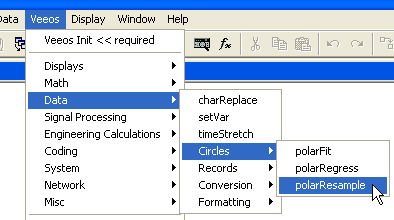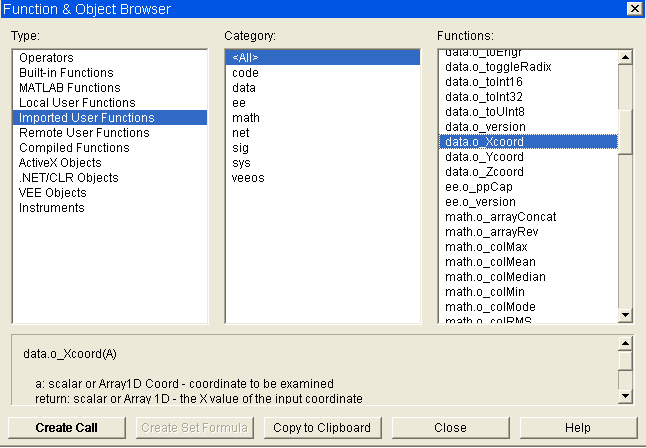Users Guide
The VEEOS Library is designed to be as simple and obvious to use as the
built-in VEE components. However there are also some unique capabilities that
can be exploited by the end user.
In general VEEOS objects look, feel, and act just like built-in VEE objects
except that their schemas are fixed (you can't modify the inputs and outputs).
The veeos menu integrates into the default VEE menu and allows you to
instantiate objects directly into your program and use them as you would any
native VEE object. See the
Reference Guide for details of
the various available objects, or check the included Description field for the
VEE objects for a short synopsis.

Most of the veeos objects have a
corresponding function with the same name but a prefix of "o_". Hence
you can use the polarResample object in
your program or you can call the o_polarResample() function
directly in your own code or use a VEE function call object. All of the
below objects will have exactly the same functionality. This is intentional as
it provides a great deal of flexibility for the end user.
 Taken
directly from the menu
Taken
directly from the menu
 Instantiated from the Function and
Object Browser
Instantiated from the Function and
Object Browser
 Typed manually
into a formula.
Typed manually
into a formula.
Some VEEOS functions do not have direct correspondence to VEEOS objects. Some
functions such as chebyPoly are not
suitable for general usage but are instead lower-level functionality underlying
various VEEOS features. Others such as Xcoord
have corresponding native VEE objects so adding a VEEOS object would be
redundant. Still others such as bootstrapLib.init are part of the VEEOS
structure and are not intended for direct usage.
Though these functions are not overt, they are documented and if desired can
definitely be used. Perhaps the simplest way to use these is through VEE's
Function and Object Browser. This if course after veeosInit has been run in
order to import the VEEOS libraries.

At its simplest Scripting works just like anything else in VEE. But unlike
other objects, the scripting objects provide a transparent interface that
underneath allows virtually unlimited tasks. To unlock this power does take a
little bit of configuration, as explained in Scripting.
After configuration there are several ways to utilize scripting.
- The simplest scripting is done via the
Script object. This is
designed to work similarly to VEE's built-in Matlab Script
object: one enters a script and data, runs the object and
results come out. However the
Script object allows multiple languages and 32/64 bit code
plus both local and remote operation so very significantly more
powerful than Matlab Script.
- For those who would like to generate scripts
programmatically, or read them from external files, or use an
external code editor, or would simply forgo the overhead of the
Script object, there is
the scriptPro
alternative. Here the user supplies a script, adds the
shebang
line and proceeds.
- For more advanced tasks such as executing a
single script with multiple datasets, there are the Advanced
Scripting objects (scriptInit,
sendData,
sendScript,
executeScript and
so on). As with scriptPro,
the user is responsible for the full script and
shebang,
but now is also responsible for starting the script server,
uploading data and script, executing the script, downloading
data, etc.
© 2015-2025. All Rights Reserved.
Stan Bischof (stan@worldbadminton.com).
Last updated
03 February 2023 13:03.


 Taken
directly from the menu
Taken
directly from the menu Instantiated from the Function and
Object Browser
Instantiated from the Function and
Object Browser Typed manually
into a formula.
Typed manually
into a formula.